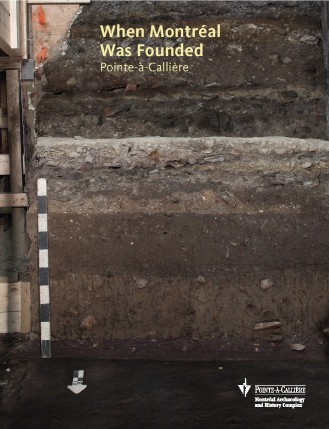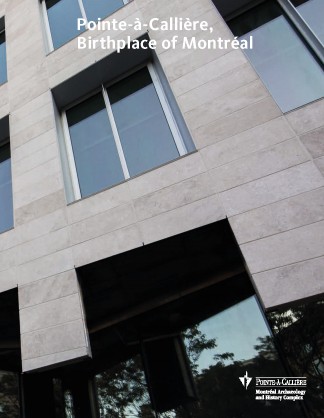November 2017
Pointe-à-Callière, where Montréal was born


The Montréal Archaeology and History Complex launches two books that highlight the history of Montréal and the museum
Montréal, November 13, 2017 – Pointe-à-Callière, the Montréal Archaeology and History Complex is launching the first two volumes in a series of six books on the history of Montréal and the museum. Produced by Pointe-à-Callière, the series marks the 25th anniversary of Montréal’s largest history museum. When Montréal Was Founded and Pointe-à-Callière, Birthplace of Montréal are the series’ first two titles. Respectively, they highlight the history of Montréal’s origins and the new museum pavilion inaugurated in May 2017, which houses the ruins of Fort Ville Marie, the city’s very first structure.
When Montréal Was Founded
The first book describes the captivating history of Montréal’s foundation and the occupation of the site at Pointe-à-Callière, now part of Old Montréal, where the museum was built. This point had been frequented by Indigenous peoples for over 1,000 years. The book relates the first contacts with these peoples by Jacques Cartier and Samuel de Champlain. It then focuses on the arrival of Jeanne Mance, Paul de Chomedey de Maisonneuve, and the “Montréalistes” who attended the first mass to found Montréal in 1642, and then covers the period during which the site was used by governor Louis-Hector de Callière to build his estate in 1695. The book thus looks back at the colony’s origins, the motivations that drove Montréal’s founders, and the hardships faced by the handful of intrepid settlers confronting an untamed land. It describes the challenges of the settlers’ everyday lives, the wars they tried to avoid, the construction of Fort Ville Marie, the initial conversions to Catholicism, and the first treaties between Europeans and Indigenous peoples. The book also examines Montréal’s foundation in light of recent archaeological and historical discoveries by archaeologists from Pointe-à-Callière and Université de Montréal.
Pointe-à-Callière, Birthplace of Montréal
The second book provides an insider’s look at the discovery of the astonishing ruins of Montréal’s first structure and the issues related to preserving and enhancing the site. The book covers the construction of the museum pavilion and the restoration of Montréal’s first collector sewer. The most important heritage legacy of the city’s 375th anniversary celebrations, this “memory space” was inaugurated on May 17, 2017. It is presented as an inheritance to preserve and pass on to future generations. The book also highlights the many challenges of bringing this unique project to fruition, from protecting the ruins of Montréal’s foundation site to selecting which artifacts to display. Readers learn how the museum, located in the heart of Montréal’s historical district, chose to make an architectural statement that is both modern and timeless, one where visitors can partake of an intimate tribute that is at the same time an active and informative exploration.
The book explains how many different people – archaeologists, historians, architects, engineers, museologists, storyboard writers, workers, and even volunteers – contributed their expertise to create this unprecedented commemorative space. This creativity in service of the place’s spirit gave voice and substance to a shared vision that respects the site’s authenticity and integrity and the memory of the founders, integrates technical innovation, and adheres to the exhibition’s restrained aesthetic. The book thus presents how the foundation site and Montréal’s first collector sewer were developed and restored. The building housing Fort Ville Marie’s ruins was also the last work of Dan S. Hanganu, an exceptional architect who recently passed away.
A series for the general public
Pointe-à-Callière’s new series will contain six books in all, forming a generously illustrated collection for the general public, akin to an elaborate tour guide. Its goal is to highlight the Montréal museum’s specific character and values. In addition to presenting Pointe-à-Callière, its mission, values, spaces, activities, energy, and uniqueness, the books will serve as a key to understanding both Montréal’s history and the Museum’s powerful appeal, which has attracted some 10 million visitors over the past 25 years.
Credits and acknowledgements
Both books were written by Annick Poussart, under the direction of Francine Lelièvre, executive director of Pointe-à-Callière. They are available at the Museum’s shop and online for $12.95.
About Pointe-à-Callière
Rising above the birthplace of Montréal, Pointe-à-Callière is the city’s largest history museum. It is a complex comprised of a series of historic and archaeological sites of national significance that showcase major periods in the history of Montréal, from 1350 to the present day. The only large-scale archaeology museum in Québec and in all of Canada, Pointe-à-Callière opened in 1992 on the occasion of Montréal’s 350th birthday. The Museum’s mission is to raise awareness and foster an appreciation of the history of Quebec’s largest city, and to forge bonds with regional, national, and international networks concerned with archaeology, history, and urban issues. Its mandate consists of preserving and increasing access to Montréal’s heritage, which led to its creation of the Montréal Archaeology and History Complex, a world-class cultural and tourism complex that will showcase some ten historic and heritage sites in Old Montréal.
Pointe-à-Callière is subsidized by the City of Montréal.
-30-
Media: Marylène Kirouac, Communications Coordinator
[email protected] / T. 514 872-2687

